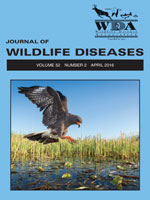Detection of West Nile virus (WNV) in ducks has been reported in North America in isolated cases of mortality in wild waterbirds and following outbreaks in farmed ducks. Although the virus has been noted as an apparent incidental finding in several species of ducks, little is known about the prevalence of exposure or the outcome of infection with WNV in wild ducks in North America. From 2004–06, we collected sera from 1,406 wild-caught American Wigeon (Anas americana), Mallard (Anas platyrhynchos), and Northern Pintail (Anas acuta) ducks at national wildlife refuges (NWRs) in North Dakota and Wood Ducks (Aix sponsa) at NWRs in South Carolina and Tennessee. We measured the prevalence of previous exposure to WNV in these ducks by measuring WNV antibodies and evaluated variation in exposure among species, age, and year. Additionally, we evaluated the performance of a commercial antibody to wild bird immunoglobulin in duck species that varied in their phylogenetic relatedness to the bird species the antibody was directed against. As determined by a screening immunoassay and a confirmatory plaque reduction neutralization assay, the prevalence of WNV antibody was 10%. In light of experimental studies that show ducks to be relatively resistant to mortality caused by WNV, the antibody prevalence we detected suggests that wild ducks may be less-frequently exposed to WNV than expected for birds inhabiting wetlands where they may acquire infection from mosquitoes.
How to translate text using browser tools
1 April 2016
SURVEY FOR WEST NILE VIRUS ANTIBODIES IN WILD DUCKS, 2004–06, USA
Erik K. Hofmeister,
Mark D. Jankowski,
Diana Goldberg,
J. Christian Franson
ACCESS THE FULL ARTICLE

Journal of Wildlife Diseases
Vol. 52 • No. 2
April 2016
Vol. 52 • No. 2
April 2016
American Wigeon
Duck
mallard
northern pintail
serologic response
West Nile virus
Wood Duck




